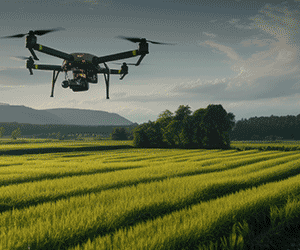A study carried out by the University of Zaragoza and the JRC evaluated the impact of macroeconomic, climatic, and agronomic factors on the agricultural crop water footprint in the African continent, using econometric panel data techniques and considering potential spatial relationships.
The results reveal a significant spatial dependence in the water footprint across neighbouring countries, thus confirming the existence of spatial relationships and highlighting the need for coordinated cross-border policies to enhance a more efficient use of water.
These spatial relationships in the water footprint are primarily due to shared hydrogeological conditions (common land conditions that affect agricultural production capability) and to the tendency of countries to imitate their neighbours’ decisions regarding aspects such as the type and volume of crops produced, or policies aimed at improving water efficiency, among others.
Among the water footprint drivers considered, per capita GDP emerged as the most influential, indicating that economic development facilitates a reduction in water requirement per unit of production due to technological advancements, improved infrastructural capacity, and more stable economic and political conditions.
While factoring in the corresponding yield impacts, the temperature increase reduces the water footprint, suggesting that higher average temperatures lead to greater aridity, which incentivises a more efficient use of water. Since temperature change is a consequence of climate change, this result highlights how climate change adaptation measures have been implemented to compensate insufficient mitigation efforts.
Finally, researchers observe that a higher proportion of land area dedicated to agriculture tends to increase the crop water footprint in the African continent, suggesting that a larger or more extensive agricultural sector raises water needs per unit of production. The higher water footprint of more extensive agricultural systems is due to the lower yields associated to these extensive systems, which could result in lower water use efficiency.
Water footprint in 2030
To illustrate the effect that these drivers may have on future African water footprint, researchers conducted a forward-looking analysis to capture the effect that the increases in per capita GDP for the period 2016-2030 may have on the African water footprint.
To calculate the growth rate of water footprint for this period, researchers combined per capita GDP projections from the Shared Socioeconomic Pathways (SSP) database, under a middle-of-the-road scenario (SSP2 scenario) and the marginal effect of GDP per capita identified in the study. This analysis reveals that the crop water footprint in Africa would be reduced by 34%, from 2,016.44 m3/ton in 2016 to 1,338.15 m3/ton in 2030, due to an expected 60% increase in per capita GDP.
These findings support the design of adequate agricultural and water management policies to achieve sustainable and resilient food systems that can adapt to future challenges such as population growth, climate change, and other threats to human health, prosperity and environmental sustainability in Africa. In particular, the importance of the spatial effects could further justify a focus on water user performance under Africa’s Agenda 2063, the main platform for the 55 African countries to pursue a Pan-African vision on economic development and sustainability.
The study focused on the African case study due to the crucial role of its agricultural sector in eradicating hunger, improving food security, and influencing economic growth and employment. Additionally, the availability of water resources strongly conditions agricultural production and crop productivity in African countries, which are increasingly affected by drought and in which there is a large dependence on rain-fed agriculture.
Water use and water footprint
The growth in global population, urbanisation rates and economic activity, coupled with the effects of climate change, have increased the pressure on freshwater resources. Improving water efficiency is crucial to ensure sustainable withdrawals and the supply of freshwater, as defined by the SDG target 6.4. This is particularly important in the agricultural sector which accounts for 70% of withdrawals worldwide, according to the US-based Pacific Institute for Studies in Development, Environment, and Security.
The water footprint is a relevant metric to evaluate progress related to efficiency in water use. It refers to the direct and indirect usage of water within a production process and reflects the cumulative consumption of this resource per ton of crops produced, calculated through the entire supply chain. This concept has significantly contributed to empirical academic research, though some areas, such as the consideration of spatial relationships and dependencies in the water footprint between neighbouring countries, remain largely under-explored.
Background
To conduct the study Capturing the drivers of crop water footprints in Africa and its spatial patterns, researchers considered 43 African countries over the period 2002-2016 to analyse the existence of spatial relationships in the WF. After confirming the presence of spatial dependence in the water footprint, researchers estimated an econometric model that incorporates this spatial dependence when analysing the drivers of the water footprint.
As potential drivers, the model included per capita GDP (as a socioeconomic variable measuring the level of development of countries), the temperature variation (to capture environmental conditions), and the percentage of agricultural land relative to the total area of the country (indicating the importance of agriculture and the existence of a more intensive or extensive agricultural system).
Related links
Capturing the drivers of crop water footprints in Africa and its spatial patterns
The green, blue and grey water footprint of crops and derived crop products
Long-term economic growth projections in the Shared Socioeconomic Pathways
O artigo foi publicado originalmente em JRC.






















































